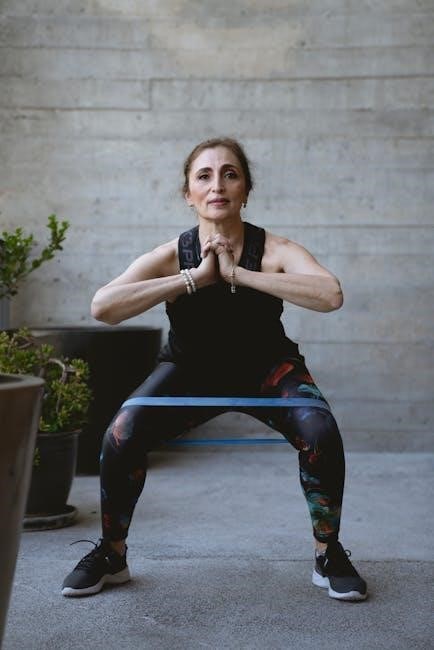Resistance bands are versatile, portable, and effective tools for building strength at home. They offer a low-impact, full-body workout suitable for all fitness levels.
1.1 What Are Resistance Bands?
Resistance bands are lightweight, portable, and versatile tools designed for strength training. Made from durable materials like rubber or fabric, they provide varying levels of resistance to challenge muscles. Unlike weights, they rely on tension created by stretching, making them ideal for full-body workouts. Resistance bands are accessible to all fitness levels, with options ranging from light to heavy resistance. Their compact design allows for easy storage and travel, making them perfect for home workouts or on-the-go exercises. This cost-effective equipment is a great alternative to traditional gym gear, offering a space-saving solution for building strength and improving flexibility;
1.2 Benefits of Using Resistance Bands for Beginners
Resistance bands are an excellent choice for beginners due to their versatility and accessibility. They are cost-effective, lightweight, and easy to store, making them ideal for home workouts. Bands provide a full-body workout, targeting multiple muscle groups simultaneously. They are low-impact, reducing the risk of injury compared to heavy weights. Additionally, resistance bands allow for controlled movements, helping improve form and prevent strain. Their portability makes them perfect for workouts on the go. With varying resistance levels, they cater to all fitness levels, ensuring a gradual and safe progression in strength training. This makes them a great starting point for beginners.
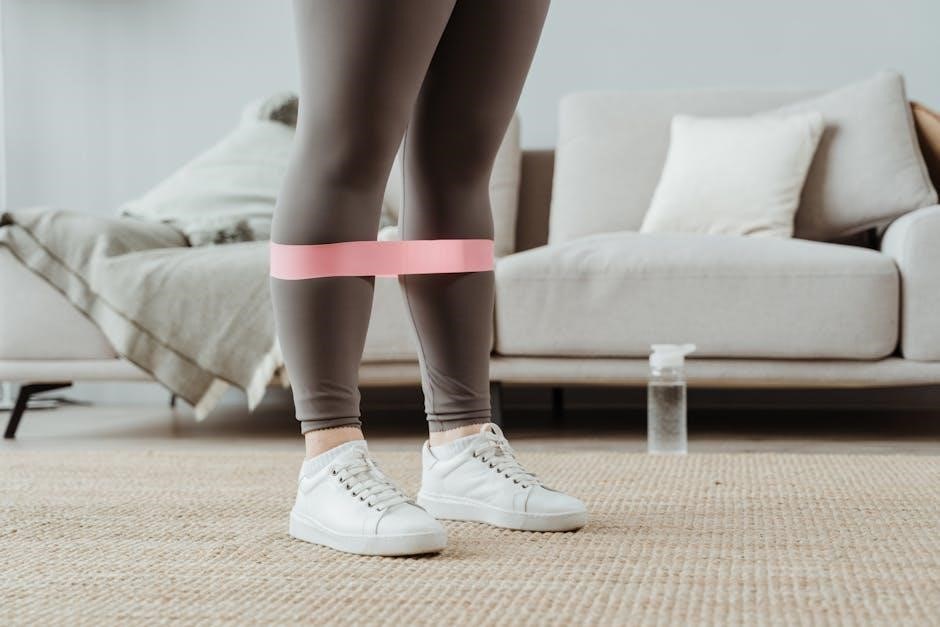
Choosing the Right Resistance Bands
Selecting the right resistance bands involves considering durability, resistance levels, and material quality. Opt for bands that suit your fitness goals and workout style.
2.1 Types of Resistance Bands Available
Resistance bands come in various styles to suit different fitness needs. Loop bands are the most common, offering versatility for full-body workouts. Tube bands feature handles for better grip and control, ideal for exercises like chest presses. Therapy bands are lightweight and perfect for rehabilitation or low-intensity training. Figure-eight bands, or bowtie bands, target specific muscle groups like the legs and glutes. Fabric resistance bands are durable and comfortable, often used for pilates or yoga. Each type caters to different preferences, making it easy to find one that matches your fitness goals and workout style.
2.2 How to Select the Ideal Resistance Level
Choosing the right resistance level is crucial for effective workouts. Resistance bands are typically color-coded, with lighter colors indicating lower resistance and darker colors representing higher levels. Beginners should start with lighter resistance to master proper form and gradually increase as they build strength. Consider your fitness goals and current strength level when selecting. If the band feels too easy, move to the next level. Always prioritize proper form over higher resistance to avoid injury and ensure muscle engagement. Start light and progress as you grow stronger for optimal results.
Setting Up Your Workout Routine
A well-structured routine balances frequency, intensity, and rest. Start with 3-4 sessions weekly, focusing on full-body or split workouts. Allow rest days for recovery.
3.1 Creating a Beginner-Friendly Workout Schedule
A beginner-friendly workout schedule should prioritize consistency and gradual progress. Aim for 3-4 resistance band sessions per week, allowing at least one rest day between. Start with shorter workouts (20-30 minutes) and gradually increase duration as you build endurance. Focus on full-body or split routines, such as upper body one day and lower body the next. Incorporate a mix of strength and mobility exercises to promote balanced fitness. Rest days are crucial for muscle recovery and growth. Stick to a predictable schedule to build a sustainable routine and track progress weekly for motivation.
3.2 Importance of Warm-Up and Cool-Down Routines
Warm-up and cool-down routines are essential for a safe and effective resistance band workout. A dynamic warm-up prepares your muscles for exercise by increasing blood flow and flexibility, reducing the risk of injury. Cool-down stretches help relax muscles, improve circulation, and prevent soreness. Incorporate light cardio and mobility exercises, such as arm circles or leg swings, during warm-ups. Post-workout, focus on static stretches for major muscle groups. These routines enhance recovery, promote muscle balance, and support long-term fitness goals. Consistency in these practices ensures a healthier and more enjoyable workout experience for beginners.
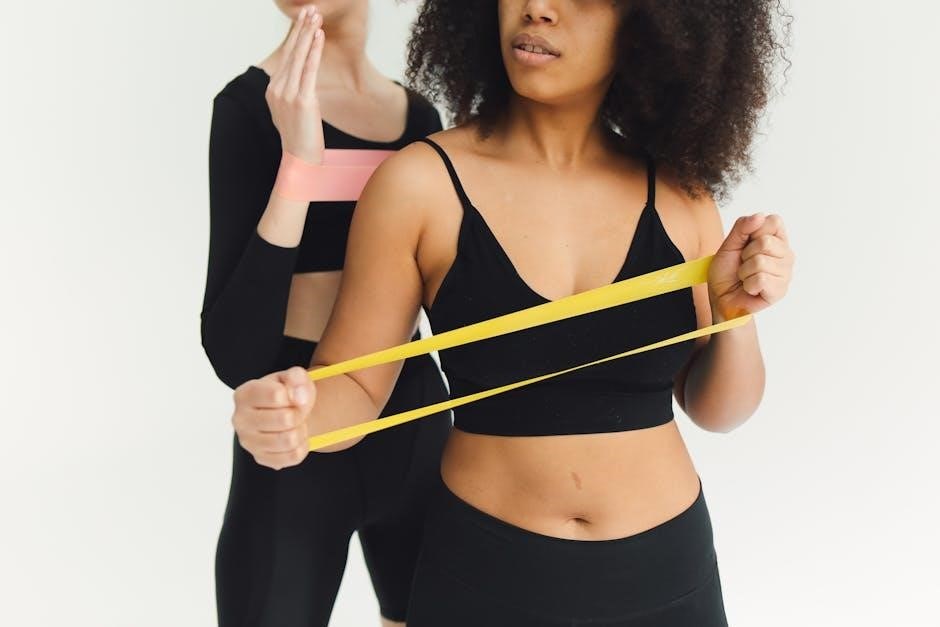
Lower Body Exercises with Resistance Bands
Lower body exercises with resistance bands target legs, glutes, and calves effectively. They improve strength and mobility with minimal equipment. Versatile and easy for home workouts.
4.1 Squats with Resistance Bands
Squats with resistance bands are an excellent lower body exercise for beginners. Start by looping the band around your thighs or under your feet. Stand with feet shoulder-width apart, engage your core, and lower your body into a squat. Keep your chest up and knees behind your toes. Push through your heels to return to a standing position. This exercise targets quadriceps, hamstrings, glutes, and core muscles; It’s a great compound movement for building overall lower body strength. Adjust the resistance level based on your fitness level and ensure proper form to avoid injury. Perfect for home workouts!
4.2 Lunges Using Resistance Bands
Lunges with resistance bands are a powerful exercise for targeting the legs and glutes. Begin by looping the band around your thighs or securing it under your feet. Stand with feet together, engage your core, and take a large step forward. Lower your body into a lunge, keeping your chest upright and your back knee nearly touching the ground. Push back to the starting position and repeat on the other side. This exercise strengthens the quadriceps, hamstrings, and glutes while improving balance. Focus on maintaining proper form to avoid injury and adjust the resistance as needed for your fitness level. Incorporate lunges into your routine for a strong lower body workout.
4.3 Glute Bridges with Resistance Bands
Glute bridges with resistance bands are an effective exercise for strengthening the glutes and hamstrings. Lie on your back with knees bent and feet flat on the floor. Loop the resistance band around your hips or thighs. Slowly lift your hips toward the ceiling, squeezing your glutes at the top, then lower back down. This movement targets the posterior chain, improving posture and hip mobility. Keep the movement controlled to maximize results and avoid strain. Adjust the band’s resistance based on your strength level for an optimal workout. Incorporate glute bridges into your routine for stronger, toned glutes and better overall lower body strength.
4.4 Calf Raises Using Resistance Bands
Calf raises with resistance bands are an excellent way to strengthen and tone the lower leg muscles. Stand on the middle of the band with feet shoulder-width apart, holding the ends of the band in your hands. Slowly raise your heels off the ground, squeezing your calves at the top, then lower back down. This exercise improves balance, muscle endurance, and ankle stability. Focus on controlled movements to avoid jerky motions. Aim for 12-15 repetitions per set and adjust the resistance level as you progress. Consistency will help build stronger, more defined calves over time.

Core Strengthening Exercises
Strengthening your core with resistance bands enhances stability, balance, and overall fitness. Simple exercises like planks, twists, and crunches target abdominal muscles effectively without heavy equipment.
5.1 Plank Rows with Resistance Bands
Plank rows with resistance bands are an excellent core-strengthening exercise that targets the abs, obliques, and upper back muscles. To perform, anchor the band securely and start in a plank position with hands on the band. Engage your core, pull the band toward your chest, and return to the starting position. This exercise improves posture, enhances stability, and boosts overall core strength. Beginners can modify the resistance level by adjusting the band’s tension or the width of their stance. Consistency and proper form are key to maximizing results and preventing injury.
5.2 Russian Twists Using Resistance Bands
Russian twists with resistance bands are an effective exercise for targeting the obliques and improving core stability. Sit on the floor with knees bent, hold the band in both hands, and lean back slightly. Engage your core, twist your torso to one side, and pull the band toward your chest. Alternate sides with controlled movements. This exercise enhances rotational strength and posture. Beginners can start with lighter resistance and gradually increase as they build strength. Proper form and consistent practice yield the best results for a stronger, more defined core.
5.3 Bicycle Crunches with Resistance Bands
Bicycle crunches with resistance bands are a dynamic exercise that targets the entire core, including the rectus abdominis and obliques. Lie on your back, hold the band in both hands, and lift your legs, bending them at a 90-degree angle. Alternate bringing one elbow to the opposite knee while extending the other leg, maintaining tension in the band throughout. This exercise mimics the motion of pedaling a bicycle, engaging your core for a full workout. Start with slower movements to focus on form, then increase speed as you gain confidence. It’s a great way to build a stronger, more defined midsection.
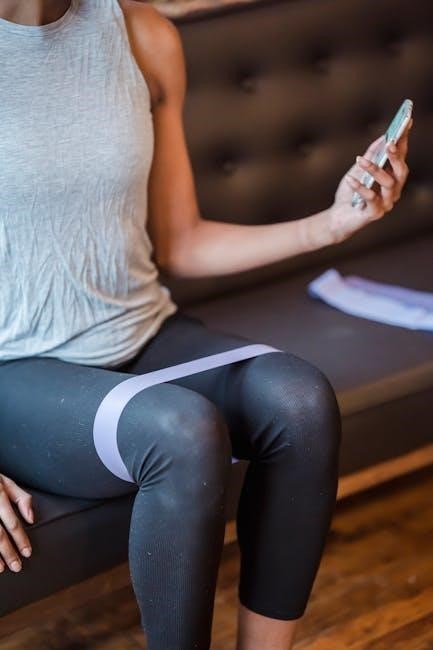
Chest and Shoulder Exercises
Target your chest and shoulders with resistance bands for a strong, defined upper body. Effective exercises like chest presses and lateral raises build muscle and improve posture.
6.1 Push-Ups with Resistance Bands
Enhance your push-up routine with resistance bands for added intensity. Loop the band across your upper back and under your hands to target chest, shoulders, and triceps. This variation increases resistance, helping build strength and endurance. Start in a plank position, engage your core, and lower your body until your chest nearly touches the ground. Push back up, maintaining proper form. Resistance band push-ups are ideal for beginners looking to progress their upper body workouts. They provide an effective way to challenge your muscles without heavy equipment. Consistency will lead to noticeable improvements in chest and shoulder strength.
6.2 Chest Press Using Resistance Bands
The chest press with resistance bands is an excellent exercise for targeting the chest muscles, shoulders, and triceps. Anchor the band behind your back and hold the ends in each hand. Sit or stand upright, press the band forward until your arms are fully extended, then slowly return to the starting position. This exercise mimics a dumbbell chest press but is more portable and adaptable. Focus on maintaining proper form and using controlled movements to avoid injury. Start with lighter resistance and gradually increase as your strength improves. This exercise is perfect for building chest strength and defining muscle tone.
6.4 Lateral Raises with Resistance Bands
Lateral raises with resistance bands are a great exercise for targeting the deltoid muscles, which shape the shoulders. Stand on the band with your feet shoulder-width apart, holding the ends at your sides; With a slight bend in your elbows, lift the band out to the sides until your arms are at shoulder height. Focus on using controlled movements and avoid swinging. This exercise helps improve shoulder stability and posture. Start with lighter resistance and gradually increase as you build strength. It’s an effective way to sculpt broader shoulders and enhance overall upper body definition.
6.5 Front Raises Using Resistance Bands
Front raises with resistance bands target the front deltoids, improving shoulder strength and posture. Stand on the band with your feet hip-width apart, holding the ends at your thighs with palms facing your body. Slowly lift the band forward until your arms are parallel to the floor, keeping elbows slightly bent. Lower the band back to the starting position with control. This exercise enhances muscle definition and balance; Start with lighter resistance to focus on form and gradually increase as you gain strength. It’s an excellent way to build a more symmetrical and stronger upper body.
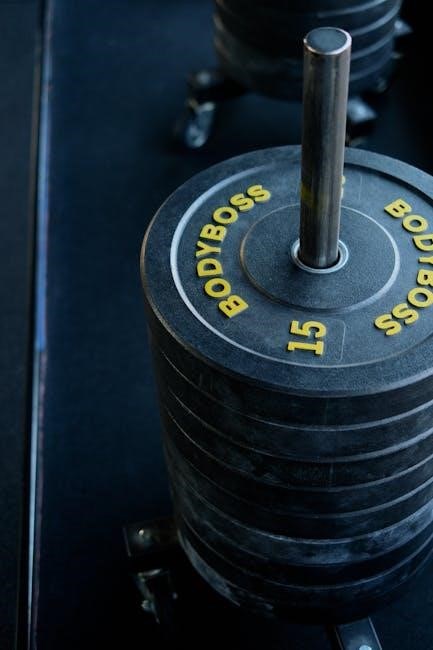
Back and Arm Exercises
Strengthen your back and arms with resistance band exercises designed to improve posture, muscle definition, and overall upper body strength. Perfect for a balanced workout routine.
7.1 Rows with Resistance Bands
Resistance band rows are excellent for targeting the back muscles, including the latissimus dorsi and rhomboids. To perform, anchor the band to a stable object and hold the ends, keeping your back straight. Pull the band toward your torso, squeezing your shoulder blades together. Focus on controlled movements to avoid jerking. This exercise improves posture, strengthens the upper back, and enhances overall muscle balance. For beginners, start with lighter resistance and gradually increase as strength improves. Proper form is key to avoid injury and maximize effectiveness.
7.2 Bicep Curls Using Resistance Bands
Resistance band bicep curls effectively target the biceps and forearm muscles. Stand on the band with your feet shoulder-width apart, holding the ends in each hand. Keep your elbows close to your body and curl the band upward, squeezing your biceps at the top. Lower slowly to the starting position. This exercise is great for building arm strength and improving grip. Use controlled movements to avoid jerking the band. Beginners can start with lighter resistance and progress as strength increases. Consistency and proper form are key for optimal results and injury prevention.
7.3 Tricep Extensions with Resistance Bands
Tricep extensions with resistance bands are excellent for targeting the triceps, improving arm strength, and enhancing definition. Anchor the band securely or hold it behind your head/shoulders. Extend your arms fully, then lower slowly to the starting position. Keep elbows close to your body to maintain proper form. This exercise helps build posterior arm muscles and enhances overall upper body stability. Beginners can start with lighter resistance and gradually increase as strength improves. Controlled movements are essential to avoid strain and maximize results. Incorporating tricep extensions into your routine can help achieve balanced arm development and improve functional strength.
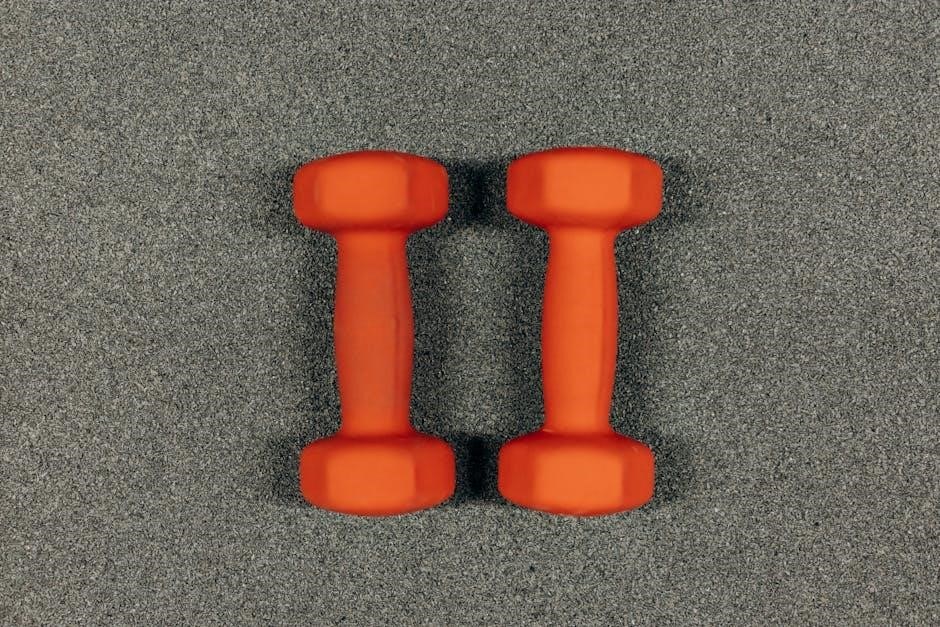
Full-Body Workouts for Beginners
Full-body workouts with resistance bands combine upper and lower body exercises for efficiency. They target multiple muscle groups, improving overall fitness and saving time. Ideal for beginners, these routines enhance strength, flexibility, and coordination, making them perfect for those seeking a balanced approach to exercise. Start with basic moves like squats, chest presses, and rows, gradually increasing intensity as you progress. Focus on proper form to maximize results and prevent injury. These workouts are versatile, convenient, and effective for achieving a well-rounded physique from home or on the go.
8.1 Circuit Training with Resistance Bands
Circuit training with resistance bands is a dynamic way to engage multiple muscle groups in a single session. It involves performing a series of exercises sequentially with minimal rest. For beginners, a circuit might include 6-8 exercises like banded squats, chest presses, and rows. Each exercise is performed for 30-45 seconds, followed by 15-30 seconds of rest. This approach improves cardiovascular fitness, builds strength, and enhances endurance. Circuit training is time-efficient and can be customized to suit different fitness levels by adjusting resistance and rest periods. It’s an excellent way to stay motivated and achieve a full-body workout.
8.2 Combining Upper and Lower Body Exercises
Combining upper and lower body exercises with resistance bands creates a balanced workout that targets multiple muscle groups simultaneously. For example, pairing chest presses with squats or bicep curls with lunges works both the upper and lower body efficiently. This approach saves time and enhances coordination. Beginners can alternate between upper and lower body moves to maintain flow. Structuring workouts this way helps improve overall fitness and ensures a well-rounded strength training routine. It’s ideal for those aiming to build full-body strength without spending hours in the gym. This method also boosts metabolism and keeps workouts engaging.
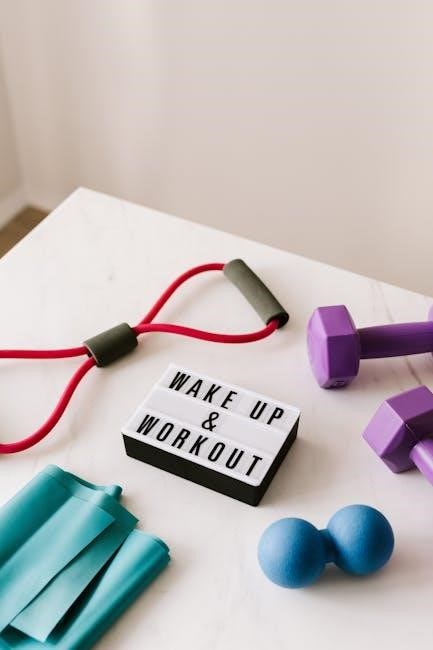
Progression and Safety Tips
Progression and safety are key to effective resistance band workouts. Start with lighter bands and gradually increase resistance as strength improves. Focus on proper form to avoid injuries and ensure muscle engagement. Rest between sets and stay hydrated. Listen to your body to prevent overexertion. Consistency and patience yield the best results while maintaining safety throughout your fitness journey.
9.1 Gradually Increasing Resistance Levels
Gradually increasing resistance levels is essential for continuous progress in resistance band exercises. Start with lighter bands and progress to heavier ones as your strength improves. This prevents plateaus and ensures steady muscle development. Monitor your workouts to identify when it’s time to increase resistance, such as when exercises become too easy. Swap to thicker bands or layer multiple bands for added challenge. Consistency and patience are key—avoid rushing progression to prevent overexertion. Track your progress and adjust resistance levels accordingly to maintain a safe and effective workout routine.
9.2 Avoiding Common Mistakes in Form
Maintaining proper form is crucial when using resistance bands to maximize effectiveness and prevent injury. Common mistakes include overstretching the bands, improper anchoring, and using an incorrect stance. Ensure the bands are securely anchored and aligned with your body position. Avoid arching your back or using momentum, as this can lead to poor form and potential harm. Focus on slow, controlled movements to engage the target muscles effectively. Consulting instructional guides or videos can help beginners master proper techniques and avoid these pitfalls, ensuring a safe and productive workout experience.

Nutrition and Recovery for Optimal Results
Proper nutrition and recovery are essential for maximizing the benefits of resistance band exercises. A balanced diet, adequate hydration, and sufficient sleep support muscle growth and repair. Incorporating recovery techniques like stretching and foam rolling enhances flexibility and reduces muscle soreness, ensuring a successful fitness journey.
10.1 Importance of Proper Nutrition
Proper nutrition is vital for maximizing the benefits of resistance band exercises. A balanced diet ensures that your body has the necessary fuel to perform workouts effectively and recover afterward. Focus on consuming lean proteins, complex carbohydrates, and healthy fats to support muscle growth and energy levels. Additionally, staying hydrated is crucial for maintaining performance and overall health. A well-planned meal schedule helps prevent fatigue and supports muscle repair, making it easier to stick to your resistance band exercise routine and achieve your fitness goals.
10.2 Recovery Techniques for Muscle Growth
Recovery is crucial for muscle growth after resistance band exercises. Ensure adequate rest and sleep for muscle repair. Incorporate gentle stretching or yoga to improve flexibility and reduce soreness. Foam rolling helps alleviate muscle tension. Stay hydrated to support recovery processes. Consider supplements like protein shakes or creatine to aid muscle repair and growth. Listen to your body and adjust your routine based on recovery needs. A consistent recovery routine will lead to better results and enhance overall muscle development effectively over time.
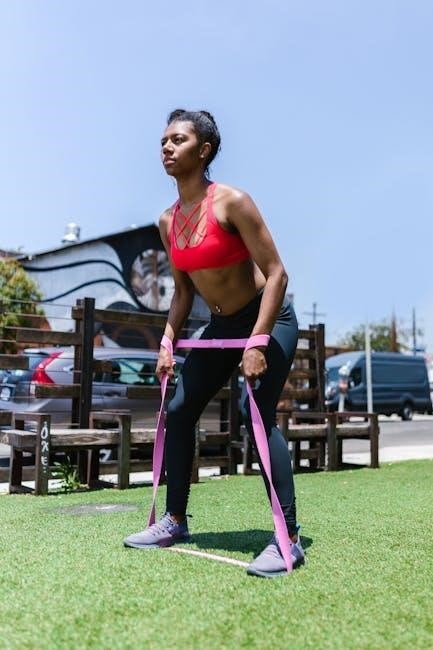
Printable PDF Resources for Beginners
Discover printable PDF guides tailored for beginners, offering step-by-step exercise instructions, workout plans, and progress charts to enhance your resistance band training experience effectively.
11.1 Finding Reliable Resistance Band Exercise Guides
To find reliable resistance band exercise guides, start by exploring official fitness websites, trusted sports medicine organizations, and reputable online platforms. Look for guides endorsed by certified trainers or physical therapists. Always check reviews and ratings to ensure the guide is suitable for beginners. Many reliable sources offer free downloadable PDFs with step-by-step instructions, accompanying images, and safety tips. Prioritize guides that focus on proper form and progression. Ensure the content aligns with your fitness goals and skill level. Reliable guides will also emphasize consistency and proper technique to maximize results and prevent injuries.
11.2 Downloadable Workout Plans and Charts
Downloadable workout plans and charts are excellent tools for organizing your resistance band exercises. Many fitness websites and wellness apps offer free PDF templates tailored for beginners. These resources often include customizable workout calendars, exercise logs, and progress trackers. Visual charts can help you plan routines, track repetitions, and monitor improvements. Look for plans that provide clear instructions, sets, and reps. Printable charts are ideal for staying motivated and maintaining consistency. Ensure the plans align with your fitness goals and are designed for your experience level. Downloading these tools can enhance your workout structure and accountability.
Resistance band exercises offer a versatile, portable, and cost-effective way to build strength and enhance flexibility. This guide provides a comprehensive start for beginners, ensuring safe and effective workouts. By following the outlined routines and tips, you can achieve your fitness goals. Remember, consistency and proper form are key to success. Start your journey today and enjoy the benefits of resistance band training!
12.1 Summary of Key Takeaways
This guide provides a comprehensive introduction to resistance band exercises, tailored for beginners. It covers the basics of resistance bands, their benefits, and how to choose the right ones. Detailed workout routines for different muscle groups, including lower body, core, chest, shoulders, back, and arms, are included. Emphasis is placed on proper form, progression, and safety. The importance of nutrition and recovery is also highlighted to support muscle growth and overall fitness. By following this structured approach, beginners can effectively incorporate resistance band exercises into their fitness journey and achieve their goals.
12.2 Encouragement to Start Your Fitness Journey
Starting your fitness journey with resistance bands is an excellent decision! These versatile tools are perfect for beginners, offering a convenient and effective way to build strength and improve flexibility. Remember, fitness is a journey, and every small step counts. Don’t be intimidated—begin with simple exercises and gradually progress. Consistency is key, and celebrating small victories will keep you motivated. With dedication and the right approach, you’ll achieve your fitness goals and enjoy the benefits of a healthier, stronger you. Embrace the process and take the first step today!
